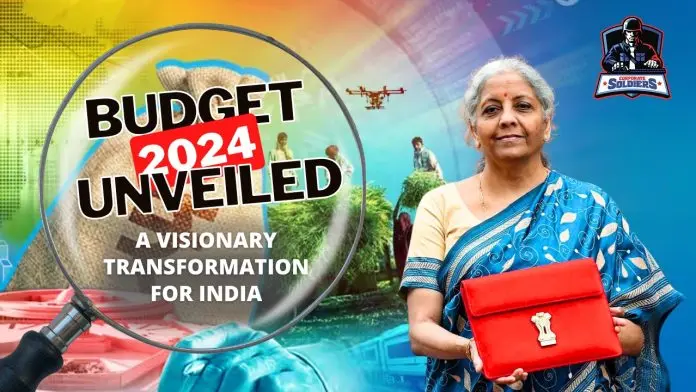Finance Minister Nirmala Sitharaman presented the Interim Union Budget for the fiscal year 2024-25 in Parliament today. Marking the sixth budget under the current FM, this also serves as the final budget of Prime Minister Narendra Modi’s second term in office.
Following the Lok Sabha Elections, the complete budget is scheduled for presentation in July this year. The budget prioritized fiscal consolidation, infrastructure, agriculture, sustainable growth, and railways. Regrettably, there were no alterations in tax rates, leaving salaried individuals disappointed. The Fiscal Deficit target for FY25 was set at 5.1 percent of the GDP, surpassing expectations, and the capex target for FY25 was raised by 11.1 percent to ₹11.1 lakh crore. Finance Minister Sitharaman highlighted the positive transformation of the Indian economy over the last decade and expressed optimism for the future.
Budget 2024: Government Aims for Unprecedented Development, Sets FY25 Fiscal Deficit Target at 5.1% of GDP”
In envisioning a trajectory towards becoming a developed country by 2047, Finance Minister Sitharaman declared the next five years as a period of unparalleled development. Emphasizing the transformative potential of the “trinity of democracy, demography, and diversity,” she asserted that these elements can fulfill the aspirations of every Indian.
The Finance Minister remains committed to enhancing domestic macroeconomic factors by prioritizing ongoing investments in infrastructure, agriculture, and domestic tourism. Additionally, maintaining fiscal responsibility with a reduced fiscal deficit is likely to resonate positively with foreign investors. The anticipated $25 billion bond inclusion in June, coupled with lower budget deficits and streamlined borrowings, is seen as a potential catalyst for reducing yields and possibly paving the way for a ratings upgrade, according to Pradeep Gupta, Co-founder & Vice-chairman of Anand Rathi Group.
In a significant move, the budget places a strong emphasis on infrastructure, tourism, logistics, and innovation in research. These strategic measures are poised to foster sustained and continuous growth for the economy. The commitment of the current government to prioritize fiscal prudence is evident, aiming to achieve the targeted fiscal deficit of 4.5 percent of GDP by FY26, as highlighted by Gupta.
2024 Budget Unveiled: Tax, Green Energy, Tourism Updates etc.
In her Budget speech, Finance Minister Sitharaman declared, “…I do not propose any alterations in tax rates, both in direct and indirect taxes, including import duties.” Despite the absence of changes in the tax structure, she highlighted a noteworthy achievement – tax collections more than doubled in the past decade. Additionally, she emphasized the reduction of the average processing time for tax returns to 10 days this year.
Relief for Taxpayers as Old Outstanding Demands up to ₹25,000 to be Withdrawn
The Finance Minister reports a notable achievement with tax collections doubling over the past decade. The current budget maintains stability in direct and indirect taxation, including import duties. Siddhesh Mehta, Research Analyst at Samco Securities, highlights the predictability as advantageous for companies in navigating financial planning, fostering a secure and sustainable business environment.
Continuing the momentum of a substantial threefold increase in the capital expenditure outlay over the last four years, which has significantly contributed to economic growth and job creation, the Finance Minister announced a further 11.1 percent boost in the outlay for the next year, totaling ₹11.11 lakh crore. This accounts for 3.4 percent of the GDP.
Budget 2024 Allocates ₹75,000 Crore for State Reforms; Transformative Changes Unveiled for Railways
In a significant move, the budget allocates ₹75,000 crore for milestone-linked reforms in states. Finance Minister Sitharaman also revealed transformative initiatives for the railways, including the conversion of 40,000 normal rail bogies into Vande Bharat for improved safety, convenience, and passenger comfort. The expansion of key rail infrastructure projects, such as Metro Rail and Namo Bharat, is set to reach additional cities.
Additionally, the budget introduced three significant railway corridors: the port connectivity corridor, the energy, mineral, and cement corridor, and the high traffic density corridor. This strategic move aims to alleviate congestion in high-traffic corridors, enhancing the efficiency of passenger train operations and subsequently improving safety and travel speed for passengers.
FM Sitharaman Affirms Ongoing Airport Expansion and Development
Finance Minister Sitharaman asserts the continuation of airport expansion and development initiatives. Alongside dedicated freight corridors, the implementation of these three economic corridor programs is expected to accelerate GDP growth and lower logistic costs, according to Sitharaman. Furthermore, following the success of Vande Bharat trains, approximately 40,000 additional rail bogies are slated to be converted to Vande Bharat coaches. Sanjay Moorjani, Research Analyst at SAMCO Securities, highlights the potential for job creation, reduced travel time, and increased tourism nationwide.
CRISIL observed that the establishment of commodity-specific economic rail corridors has the potential to alleviate congestion in existing lines, primarily in the eastern region of the country. This initiative is expected to enhance the speed of freight movement, reduce turnaround times, and contribute to lowering India’s logistics costs from 12 percent of GDP. The positive impact on competitiveness, particularly in manufacturing, positions India favorably against its peers.
Expansion of ‘Lakhpati Didi’ Scheme: FM Raises Target to 3 Crore from 2 Crore
The Finance Minister announces an increase in the target for the ‘Lakhpati Didi’ Scheme from 2 crore to 3 crore, citing the remarkable impact of eighty-three lakh self-help groups (SHGs) involving nine crore women. These SHGs have been pivotal in transforming the rural socio-economic landscape, fostering empowerment and self-reliance. The success of the initiative has already led to nearly one crore women achieving the status of ‘Lakhpati Didi.’
The Lakhpati Didi Scheme, designed to empower two crore women in rural areas, has demonstrated remarkable success, engaging 83 lakh self-help groups and benefiting 9 crore women. With a substantial financial injection of ₹1 lakh per household for one crore beneficiaries, this initiative is positioned to bring about a substantial improvement in the economic status of rural women. Beyond stimulating the rural economy, this empowerment is expected to boost credit demand for micro-financiers, particularly from women and self-help groups, potentially alleviating stress on asset quality concerns, according to Veer Trivedi, Research Analyst at SAMCO Securities.
Electricity Initiative: 1 Crore Households Eligible for Up to 300 Units of Free Electricity, Announces FM Sitharaman
In a significant move, Finance Minister Sitharaman unveils a plan where 10 million households can benefit from up to 300 units of free electricity monthly through roof-top solarisation. This initiative aligns with the Prime Minister’s commitment, declared on the historic day of the consecration of Shri Ram Mandir in Ayodhya. Sitharaman emphasizes the potential for households to save between ₹15,000-18,000 annually through free solar electricity and selling surplus energy to distribution companies.
Green Energy Revolution Unveiled: Key Measures for ‘Net Zero’ by 2070
- Offshore Wind Energy Boost: Kickstarting the journey, viability gap funding will support harnessing one giga-watt of offshore wind energy potential.
- Coal Transformation: Aiming for a cleaner future, plans include setting up coal gasification and liquefaction capacity of 100 MT by 2030, reducing reliance on natural gas, methanol, and ammonia imports.
- Eco-Friendly Fuel Mandate: Introducing a phased mandatory blending of compressed biogas (CBG) in compressed natural gas (CNG) for transport and piped natural gas (PNG) for homes, ensuring a sustainable shift in energy consumption.
- Biomass Empowerment: Financial assistance initiatives will facilitate the procurement of biomass aggregation machinery, bolstering the collection process and supporting green energy evolution.
- Inflation Moderation Confirmed by FM Sitharaman: A Snapshot of Budget 2024
Addressing concerns about inflation, Finance Minister Nirmala Sitharaman reassures the public that inflation remains ‘moderate,’ providing stability to the economic landscape.
- Electric Vehicle Revolution Accelerates: A Pivotal Move in Budget 2024
In a bold stride towards a sustainable future, the government announces plans to bolster the Electric Vehicle (EV) ecosystem by supporting manufacturing and charging infrastructure. Finance Minister Sitharaman emphasizes the encouragement of greater ebus adoption in public transport networks, facilitated by secure payment mechanisms.
- Transformative Strategy to Overcome EV Adoption Hurdles
CEO at Staffing, TeamLease Services, Kartik Narayan, commends the forward-thinking strategy of the Indian government in the 2024-25 Union Budget. The focus is on addressing a key barrier to EV and hybrid vehicle adoption—the shortage of public charging stations. Narayan highlights the government’s commitment to incentivize and significantly expand the electric vehicle ecosystem, paving the way for increased charging stations. This visionary initiative is poised to transform India’s EV landscape, alleviate range anxiety, and position electric vehicles as a compelling, sustainable transport solution for the future.
- Revitalizing Tourism
Finance Minister Sitharaman reveals a strategic plan to boost tourism, urging states to comprehensively develop iconic tourist centers with global branding and marketing. A quality-based rating system for facilities and services is on the horizon, backed by long-term interest-free loans to states for financing these developments. The focus extends to projects for port connectivity, tourism infrastructure, and amenities on islands, including Lakshadweep, fostering employment generation. The announcement signifies a significant step toward reinvigorating the tourism sector and promoting India as a global travel destination.
- Promoting Investments: A Golden Era of FDI Inflows
Highlighting a remarkable period, FDI inflow from 2014-23 reached $596 billion, doubling the figures from 2005-14. To sustain foreign investment momentum, the government actively engages in negotiating bilateral investment treaties, aligning with the ethos of ‘first develop India.
- Technology’s Impact Unveiled by FM Sitharaman
Recognizing the transformative impact of new-age technologies and data, FM Sitharaman emphasizes their role in changing lives and fostering economic opportunities. To further catalyze innovation, she unveils a corpus of ₹1 lakh crore with a fifty-year interest-free loan, aimed at encouraging significant research and innovation in sunrise domains by the private sector.
- ₹1 Trillion Funding Boost for Sunrise Sectors
The Finance Minister announces a groundbreaking ₹1 trillion funding initiative for sunrise sectors, emphasizing the pivotal role of youth and technology in shaping the nation’s future.
- Empowering Defence Tech with Deep-Tech Focus
A new scheme is on the horizon, dedicated to strengthening deep-tech technologies for defense purposes, aligning with the vision of ‘atmanirbharta,’ as revealed by the FM.
- Transformative Impact on IT Industry Predicted
Manick Wadhwa, Director at SKI Capital, hails the 50-year interest-free loan for a ₹1 lakh crore corpus as a game-changer for the IT industry and sunrise sectors. The anticipated funding surge is expected to fuel research and innovations, positioning India as a global technology leader in the next decade.
- Ayushman Bharat Expansion: Inclusivity for Anganwadi and Asha Workers
FM Sitharaman extends Ayushman Bharat cover to all Anganwadi and Asha workers, emphasizing comprehensive maternal and child healthcare schemes under a unified umbrella. This move signifies a commitment to inclusivity and holistic healthcare.
Budget 2024: FM Introduces New ‘GDP’ – Governance, Development, Performance
The Finance Minister unveils a new perspective on ‘GDP’ with a focus on Governance, Development, and Performance, reflecting a holistic approach to economic measures.
- PM Awas Yojana: Housing for All
Despite COVID challenges, the implementation of PM Awas Yojana (Grameen) persists, with the center nearing the goal of three crore houses. FM Sitharaman announces plans to take up two crore more houses in the next five years, addressing the growing need due to an increase in families.
- PMAY (Urban): Meeting Housing Goals
Launched in 2015, Pradhan Mantri Awas Yojana (Urban) aims for housing for all. The government, aiming for 3 crore pucca houses by March 2024, is close to achieving this target. An additional plan to build 2 crore more houses over the next five years signals sustained commitment, triggering increased investments and activity in the construction sector. This is expected to have a positive impact on various industries, including Housing Finance, Cement, Steel, and Paints, fostering growth across sectors.
- New Housing Scheme for Middle-Class Citizens : The government plans to launch a housing scheme specifically for middle-class citizens, aiming to enhance accessibility to housing options.
- MSMEs: Boosting Global Competitiveness through Training
A key focus is on providing training to Micro, Small, and Medium Enterprises (MSMEs) to compete on a global scale. The government is committed to facilitating their growth by preparing the financial sector to meet their investment needs.
- Skill India Mission’s Impact on Job Creation
CEO of Staffing at Teamlease Services, Kartik Narayan, highlights the significance of the Skill India Mission’s initiative, aiming to train 1.4 crore young individuals and upskilling and re-skilling 54 lakh youth. The establishment of 3,000 new Industrial Training Institutes (ITIs) is a crucial step to bolster the Production-Linked Incentive (PLI) and Make in India programs. This holistic approach is vital for increasing the manufacturing sector’s contribution to GDP from 17 percent to 25 percent by 2047, creating numerous job opportunities.
FM Unveils Plans for Global MSME Competitiveness
The Finance Minister announces a strategic initiative to provide training to Micro, Small, and Medium Enterprises (MSMEs), aiming to enhance their global competitiveness.
Agriculture and Food Processing: Boosting Farmer Income
FM highlights increased efforts for value addition in agriculture to boost farmers’ income. Pradhan Mantri Kisan Sampada Yojana has already benefited 38 lakh farmers and generated 10 lakh employment opportunities. The Pradhan Mantri Formalisation of Micro Food Processing Enterprises Yojana has assisted 2.4 lakh Self-Help Groups (SHGs) and sixty thousand individuals with credit linkages. Various schemes are collectively addressing post-harvest losses and working towards improving productivity and incomes.
Promoting Growth in Agriculture Sector
To accelerate the sector’s growth, the government plans to further encourage private and public investment in post-harvest activities, including aggregation, modern storage, efficient supply chains, primary and secondary processing, marketing, and branding. This comprehensive approach aims to strengthen the entire agricultural value chain for sustainable growth.
Budget 2024: Financial Assistance to 11.8 Crore Farmers, Fiscal Targets, and More
- Farmers’ Aid: A staggering 11.8 crore farmers receive crucial financial assistance, underlining the government’s commitment to agricultural support.
- Fiscal Responsibility:The fiscal deficit target for FY25 is set at 5.1 percent of GDP, showcasing a prudent approach to financial management.
- Revised Targets: The fiscal deficit target for FY24 is revised down to 5.8 percent of GDP from the earlier estimate of 5.9 percent, indicating improved fiscal control.
- Capital Expenditure Boost: FY25 capital expenditure gets a significant boost, set at ₹11.1 lakh crore, reflecting an 11.1 percent increase for crucial developmental projects.
- Total Expenditure Outlook: FY25 total expenditure is anticipated to reach ₹30.80 lakh crore, demonstrating the government’s commitment to key sectors. The revised estimate for FY24 total expenditure stands at ₹44.90 lakh crore.
- Revenue Receipts: The strong growth momentum and formalization of the economy are reflected in higher-than-expected revenue receipts for FY24, reaching ₹30.03 lakh crore.
- Borrowing Plans: FY25 gross market borrowing is pegged at ₹14.13 lakh crore, with net borrowing set at ₹11.75 lakh crore, indicating a measured approach to debt management.
- Tax Targets: FY25 gross tax receipts are targeted at ₹26.02 lakh crore, signaling the government’s reliance on robust revenue collection for sustainable economic growth.
Budget 2024: NDA Places Top Priority on Women, Farmers, Youth, and the Poor
Finance Minister Nirmala Sitharaman emphasized on Thursday that women, farmers, youth, and the poor are identified as priority segments by the NDA government, anticipating a return to power in the upcoming national polls.
The interim budget for FY25 will prioritize sections of society, with a focus on empowering the poor. In her sixth union budget speech, Finance Minister Sitharaman highlighted the shift from the previous entitlement-based approach to addressing poverty, emphasizing the importance of empowering the poor as active partners in the development process. According to Sitharaman, this empowerment not only benefits the individuals but also enhances the government’s ability to support them more effectively.
Farmers, known as the “anna data” or food providers, receive direct financial assistance through the PM-Kisan Samman Yojana, benefitting 11.8 crore farmers annually. Additionally, 4 crore farmers are covered under the PM Fasal Bima Yojana for crop insurance. These programs, among others, play a crucial role in supporting farmers to produce food for the country and the world, according to Sitharaman.
Emphasizing the significance of empowering the youth, the minister highlighted the momentum gained in women’s empowerment through entrepreneurship, improved living conditions, and enhanced dignity under the NDA’s administration. Notable achievements include providing 300 million Mudra Yojana loans to women entrepreneurs and witnessing a 28% increase in female enrollment in higher education over the past decade. These efforts contribute to the growing participation of women in the workforce, she added.
The government has taken steps to enhance the dignity of women by making ‘Triple Talaq’ illegal, reserving one-third of seats for women in the Lok Sabha and State legislative assemblies, and allocating over 70% of houses under PM Awas Yojana in rural areas to women as sole or joint owners, according to Sitharaman.
In her speech, the minister also emphasized the importance of members of the tribal community. The PM-JANMAN Yojana is reaching out to particularly vulnerable tribal groups who have been excluded from development efforts so far. The Janjati Adivasi Nyaya Maha Abhiyan scheme aims to ensure that members of vulnerable tribal groups receive their entitlements and basic facilities.










